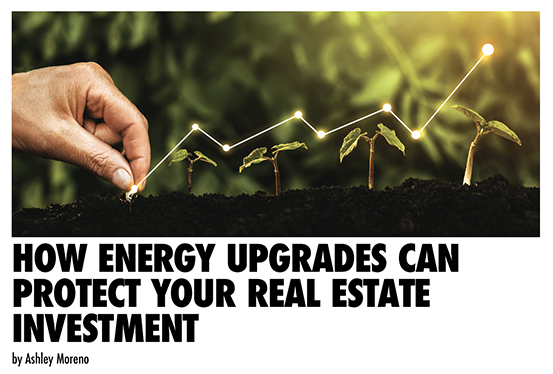How energy upgrades can protect your real estate investment

Energy use per square foot is about 10 to 35 percent lower in owner-occupied housing than in rentals, according to a report by Harvard’s Joint Center for Housing Studies.[1] The study attributes the discrepancy to the so-called “split-incentive problem.” If landlords don’t pay utility bills, then they have little incentive to make energy-efficient upgrades. Since tenants don’t own the properties, they don’t usually take on energy projects either. Historically, the split-incentive problem has posed a major challenge to the availability of energy-efficient rental properties. But rising energy costs, the pandemic, and market shifts might be changing that. More than ever, both landlords and tenants can benefit from energy-saving projects that protect the value of real estate investments, cut monthly expenses, improve tenant comfort, and build trust. Here’s why.
Energy efficiency rebates cut operating expenses—for renters and owners
This past summer, the American Council for an Energy-Efficient Economy (ACEEE) analyzed Census Bureau data collected since July 2021, finding that about one-third of the 44 million renter households in the US were behind in their energy bills within the last year. About half of those behind on their utility bills were also behind on rent.[2] The ACEEE is a nonprofit research group that develops policies to reduce energy waste and combat climate change. They say that energy efficiency upgrades can help renters stay ahead of their bills by lowering monthly energy costs, but property owners need to make efficiency upgrades. Right now, many property owners are reluctant to invest extra money in their rentals—partly due to reduced rental income since the onset of the COVID-19 pandemic. Thankfully, new incentives and programs are on the way that might help, and current programs can help cover costs in the meantime.
The new Inflation Reduction Act has programs that could support rental property retrofits, and the bipartisan infrastructure law passed last November included $3.5 billion in low-income weatherization funding and $550 million in Energy Efficiency and Conservation Block Grants for clean energy programs, says the ACEEE. Property owners can also take full advantage of rebate programs available today. For example, in California, the Multifamily Energy Savings Program (MESP)[3] provides cash rebates on turn-key upgrades and custom incentives for larger energy-savings projects.
Programs like these can help property owners make upgrades that lower monthly expenses for renters. Lowered monthly expenses can help keep tenants and attract new renters—especially as energy costs continue to rise. Property owners will also save money directly on projects for shared spaces, like laundry rooms, clubhouses, mail rooms and administrative offices.
Energy efficiency protects your investment for the long term
As demonstrated by the split-incentive problem, many property owners see direct cost savings as the primary benefit of energy efficiency upgrades. But the benefits go beyond that and continue to evolve as the COVID-19 pandemic reshapes the rental market. As more people remain permanently remote, they must now cover energy costs, like heating and cooling during peak usage hours, which in the past fell to their employers. Overall comfort and how much it costs per month to keep a unit comfortable will likely play a much bigger role in how renters choose their homes. For example, the ACEEE says that renters may value energy efficiency and indoor comfort over previously important factors, like proximity to work.[4] The group also published a study this past May highlighting how energy efficiency information impacts rental selection. They found that renters select the most efficient listings 21 percent more often and, coincidentally, the least efficient option 21 percent less often.[5] Some renters were even willing to pay more in rent for more efficient properties! This group included renters looking for apartments rather than detached houses, renters under the age of 45, and renters in the hottest and coldest climates. Plenty of renters in California fall into the first two categories. While California isn’t generally known for its weather extremes, the National Weather Service says that Coastal California is 30 to 40 percent likely to see above normal temperatures in the summer while inland areas are 40 to 50 percent likely.[6] These hotter summers may mean more potential tenants fall into the third group too.
Today, only a few cities (e.g., Minneapolis, Chicago, Gainesville and Austin) and states (e.g., Colorado and Maine) require at least some disclosure of energy information on rentals.[7] However, the ACEEE recommends that local policymakers start requiring landlords to share energy information with renters at the time of listing—a measure that most renters would likely support. How would your rental property compete in a market with increased scrutiny around monthly energy costs? How might choosing to lower your tenants’ monthly expenses improve the dynamic of your relationship with them? Energy-efficient upgrades offer a unique opportunity to future-proof your investment, and that might help put the split-incentive problem behind us.
The Multifamily Energy Savings Program (MESP) provides no-cost energy assessments, incentives for energy-saving building upgrades, and energy-saving products. Eligible existing properties include attached residences with five units or more, condos, townhomes or plex properties, apartment buildings, assisted living facilities as well as common areas typically managed by homeowner associations.



